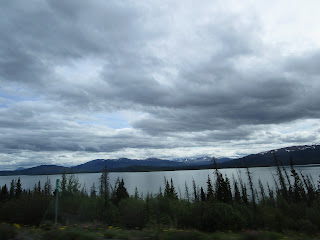Wednesday June 7 - Sunday June 10th
 |
| Kluane Lake metomorphosis |
On Wednesday, we headed north from Haines toward Fairbanks, stopping for a night each at Kluane Lake and TOK and then for two nights at Fairbanks.
As we drove up and over the pass from Haines, we left the lush, coastal rain forest and entered a barren, arctic environment. Over the pass the temperatures dropped to the mid-30's with a biting wind. This was above tree-line, but we did easily spot two bald eagles perched on a gravel hillside hunting for prey.
 |
| Top of the pass - Tatshenshini-Alsek park |
 |
This Tatshenshini-Alsek park, along with the Kluane National Park, Wrangall St Elias
and Glacier Bay comprises a UNESCO World Heritage Site - one of
the largest internationally protected, land masses on our continent |
 |
| A stark contrast to Haines |
 |
| Hurry, it is cold out here! |
As we neared Haines Junction, we entered a valley covered in permafrost and stunted black spruce (this land is commonly referred to as Taiga - the Russian name meaning "little sticks"). Black Spruce have adapted well to growing in the water-saturated, nutrient-poor soil resting on top of the permafrost layer. Some of these trees can grow to be 100 years old, but remain only two inches in diameter. The bog or muskeg resulting from plants that do not decay quickly in this muck, creates a tea-colored runoff that stains all of the streams and many of the lakes in the area.
 |
| Million Dollar Falls - notice the tea-colored water resulting from muskeg runoff |
 |
| Kluane Lake - surrounded by Black Spruce - which thrives on top of the permafrost layer |
Kluane (Clue - an - eee) Lake, the largest lake in the Yukon is receding noticeably. The
Kaskawulsh glacier that was its primary water source has retreated to such a degree that the runoff no longer runs into the Slims river, which previously fed the lake, Instead, the melt water now flows to the Alsek river which flows into the gulf of Alaska, instead. Called river piracy, the impact to Kluane Lake is auspicious since the annual rainfall of 7 inches in the area does not replenish the annual evaporation from the lake. Climate change impacts are easily visible in this sensitive, beautiful area! "The future of Kluane lake is unknown," answered the naturalists we met at the Tachal Dahl sheep-viewing visitor center. Check out this Guardian article: https://www.theguardian.com/science/2017/apr/17/receding-glacier-causes-immense-canadian-river-to-vanish-in-four-days-climate-change
 |
| An island no more... |
 |
| Wind stirs up dust clouds on the dry lake bed |
 |
| Ice and dust are disturbed by the wind |
 |
| Salmon burgers coming up! Chef Ernie |
 |
| View of Kluane Lake from our campsite |
As we headed north toward TOK the next day, the road became treacherous with potholes and frost heaves around every bend. There was no way to anticipate them. Ernie simply slowed way down and we crept along carefully, hoping not to fall into one of these holes! The little Casita rocked and rolled, but the cupboards held and our only casualty was an errant paper towel roll that unwound completely all over the cabin. It was becoming quite hot and uncomfortable (in the 80's) and the scenery was repetitive - with rolling hills, Taiga and stunted black spruce everywhere, broken now and then by random stands of White Spruce, where the soil improved. Our entertainment - names of local places and businesses: Buckshot Betty's, Moose Nugget Rd (imagine living on that one), and Bathing Beauty Pond. The Yukon in this area is quite dry and hot with little rainfall - much like the eastern Sierras.
 |
| A food cache at the Visitor Center |
We spent that night just outside of TOK at the Sourdough Campground - high on friendliness, but needing a bit of TLC, then we proceeded to Fairbanks the next day.
 |
| A comfortable spot with a view on the Braided Tenana River |
As we approached Delta and Fairbanks, the vegetation became more green and lush, so it is surprising that they typically experience around 650 fires per year here. A large number, they simply let burn. We were also surprised by the heat (in the mid-80's) and the sun here, which was quite intense and uncomfortable - we're much closer to the sun now, obviously. It stays light all night here, but it doesn't seem to bother us as long as we close our blinds and windows. It's just weird to wake up at 3:00 a.m. to see people walking around and to have it totally light outside.
We camped at Rivers' Edge RV Campground and RV Park in Fairbanks on the Chena River. It was busy and packed with travelers - but adequate for our needs. So we did our laundry, bought some groceries and are now ready to head out for 11 days in Denali, deep in the park.
 |
| We are the smallest trailer in the park as usual! We like that! |
 |
| Chena River View - provides a great reading room in the afternoon |
 |
| Wild roses decorate our site! |
Friday night we ate dinner on the deck at the Chena Grill just up from our camp spot. Ernie chose well with his fresh grilled Halibut, which was delicious! A local guitarist entertained us with late 60's songs. Today, Saturday, we visited the UAF - University of Alaska Fairbanks - Alaska Museum which offered a fascinating display of Athabascan art and culture and 2000 years of Alaskan natural history (including wooly mammoth, mastodon and muskox artifacts). Wonderful!
Tomorrow, Sunday, we will head down the Parks Hwy to Denali for one of the highlights of our trip - 11 days in the park at Teklanika campground. We are exited, packed and ready to see some bears!
























No comments:
Post a Comment